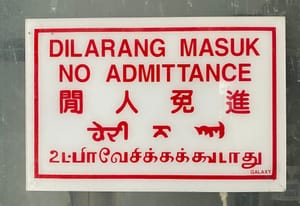I STEP OUT of the house, shoulders slumped, still half-asleep. It’s still dark; it’s before sunrise, and the white ceiling light draws my eyes to the signage by the door. Letters leap out, bold and insistent. The first row demands immediate recognition, the second edges in politely and quietly, almost apologetically. Another row curls at the bottom, delicate, easy to overlook. Yet another twists like tiny bean sprouts, odd little shapes clinging and looping, hovering between legibility and ornamentation.
Multilingual Markets: Everyday Pragmatism, Multilingual Inclusivity
In Penang’s wet markets, multilingualism is not a spectacle; it is the backdrop. At Jelutong Market, mornings echo with the sounds of metal clanging, aunties haggling, uncles ordering Nasi Lemak, motorbikes nudging through bodies. Above this bustle, the market sign presides with bureaucratic stillness. Once red, now faded white, it crowns the top of the arc: “Pasar Jelutong” in Malay. Below, three black scripts—Chinese, English, Tamil—are stacked evenly like footnotes. No one pauses to marvel at this. The sign simply works: pragmatic, inclusive, recognition without fuss. Each language extends a hand to someone, quietly accommodating the polyglot crowd. And yet, what makes this scene striking is precisely its ordinariness.





